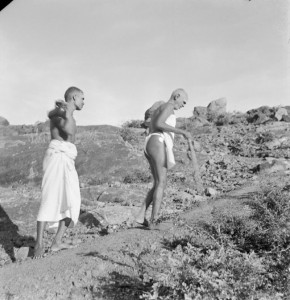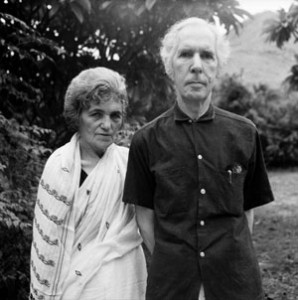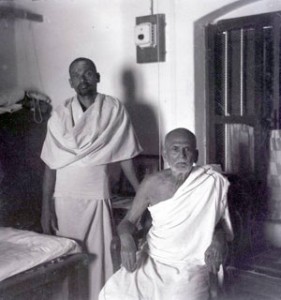Sri Ramana loved this mountain passionately. He wrote devotional poetry about it that at times verged on the ecstatic, and in all the fifty-four years he lived here, he could never be persuaded to go more than a mile from the base of the mountain.
Maalok: How did the mountain of Arunachala get to be such a powerful place? Was it because of all the pilgrims who have been coming here for centuries and worshipping it?

David: This is a question that intrigues me, but I have no answer to it. Sri Ramana said, in one of his poems, ‘Mysterious is the way it works, beyond all human understanding’. He clearly recognised its power, but I don’t think he had any explanation for it.
Years ago I heard Lakshmana Swamy make the following remarks about the mountain. ‘When I gaze at Arunachala, I know I am in the presence of jnana. There is the same energy coming off the hill that I felt when I sat in Bhagavan’s presence.’
I don’t think this kind of energy would accumulate from all the prayer and worship of devotees. In fact, I think it is the other way round. People offer worship here because, at some intuitive level, they feel the power coming off the mountain.
Lakshmana Swamy seems to sense spiritual power in unexpected places. In the days when he was more accessible, when he moved around more outside his compound, he would occasionally comment that he could sense small amounts of spiritual power in certain places, animals, trees, and even apparently inanimate objects. He seems to have an extra faculty that picks up these emanations. However, nothing remotely compared to the power that he felt radiating from the mountain of Arunachala. For him, for Sri Ramana, and for many other saints who have been drawn here, this mountain is radiating the power of the Self in a way that no other place is doing. Jnanasambandhar, a famous Tamil saint who came here in the sixth century, described it in one of his poems as a ‘condensed mass of jnana‘. I like that description. It echoes the principal myth of Arunachala in which Siva condenses himself from an effulgent column of light into the form of a mountain for the benefit of devotees who want a less blinding form to worship. Following this version of events, one can say that though the brightness of the original column of light has gone, the condensed spiritual radiance of Siva-jnana is still there. The energy that comes off the mountain is so intense, so awesome, even great saints such as Sri Ramana just gaze in wonder at it.
When Lakshmana Swamy first moved back to Arunachala about twelve years ago, he initially lived in a rented room that had no windows facing the hill. He could only see a small outcrop of rock at the base of the western side of the mountain from one of his side windows. However, that was more than enough for him. Saradamma told me that he would sit by the window and gaze, in a state of rapture, at this tiny portion of the mountain for hours together. As with his own Guru, Sri Ramana, the power emanating from the mountain drew his attention to itself and kept it fixed there.
Sri Ramana once wrote in one of his verses to Arunachala:
‘I have discovered a new thing! This hill, the lodestone of lives, arrests the movements of anyone who so much thinks of it, draws him face to face with it, and fixes him motionless like itself, to feed upon his soul thus ripened. What a wonder is this!
When there is no mind to delude you into believing that you are just looking at a form of a mountain, the power of Arunachala compels your attention to such an extent, it is sometimes hard to look anywhere else.
I was once making the seating arrangements for one of Lakshmana Swamy’s public darshans. I put his chair facing the hill.
Saradamma saw what I had done, laughed and said, If you leave it there, he won’t notice anyone. He will spend the whole time gazing at the hill. If you want him to look at the people who come, put his chair so it faces away from the hill. Then there will be no distractions.’
I asked him once, ‘How did this mountain come to be enlightened?’ It seems a strange question to ask, but I couldn’t think of phrasing it any other way. Here was this very solid mass of granite rock that was emanating the power of the Self. How did it get that way?
He said he didn’t know and couldn’t speculate. He could clearly feel its power, but he couldn’t think of any scenario that would explain how it came about.
I tried a couple of leading questions, such as, ‘Was there some enlightened being who took the form of this hill or became one with it in some way?’ He said ‘No’ to that one and to all my other proffered suggestions. In the end we were back to Sri Ramana’s comment: ‘Mysterious is the way it works, beyond all human understanding.’

The preceding sentence, by the way, says, ‘Look, there it stands as if insentient’. Ordinary people, people with minds, look at this mountain and see insentient rock. Those with true vision come here and see and feel the radiation of Siva-jnana.
Maalok: Is it true that Ramana Maharshi encouraged people to do a pradakshina around the sacred Arunachala mountain as often as possible? Isn’t recommendation of this kind of practice a bit ‘out-of-sync’ with his general teaching of being still? Could you also explain the significance of doing this pradakshina?
David: Lucia Osborne, Arthur Osborne’s wife, made an interesting comment in The Mountain Path about twenty-five years ago. She wrote that Sri Ramana never prescribed a spiritual practice for anyone unless he was first asked for advice. However, there was one exception to this rule: he often encouraged people to walk around the hill, even if they had not asked whether or not they should do it.
When Sri Ramana spoke of ‘being still’, he wasn’t talking about sitting motionless on the floor. He was speaking instead about mental silence. He advocated pradakshina of Arunachala as a means of reaching this silence. Kunju Swami has recorded a story in which Sri Ramana speaks of a kind of ‘walking samadhi‘ that sometimes overtakes one as one is doing the pradakshina.
It’s all very illogical and not even Sri Ramana had an explanation of how and why it worked. If skeptics who wanted to be convinced of the efficacy of pradakshina came to him to ask him about it, he would say, ‘Try it and see’. He had found from long experience that people who had completed one pradakshina would always enjoy it, and soon afterwards would want to do it again. After a few circuits of the hill, most people would be convinced that it was doing them some good. One became convinced by experience rather than by any sensible or rational explanation.
When Sri Ramana sent people off to do pradakshina, he was sending them to commune with his own Guru for a few hours. Walking around the base of the mountain, one is always aware of its looming presence. By being aware of the constantly changing form of the mountain as one walks around it, one is putting one’s attention on a highly charged form of the divine. And once the mind has made contact with that divine form, the grace, the energy of that form begins to flow. This is what silences people as they open themselves to the mountain’s power.
I should also mention that Sri Ramana taught that the power of this mountain is not dependent on whether or not one believes it to be divine. Sri Ramana said that it is like a fire. Those who approach it get burnt whether they believe in it or not.
Maalok: About you – what exactly made you leave everything and come to Tiruvannamalai in your early youth? Could you also share some of the surrounding circumstances, your state of mind, and the events that led to this move?
David: I first came across Sri Ramana’s teachings in 1974 by reading one of the few books about him that had been published in the West. I read this book in a few hours and immediately my whole world view was transformed. It wasn’t just a new piece of information that I could file away with all the other pieces of knowledge I had stored in my brain; it was a living transmission that completely changed the way I perceived myself and the world around me. I didn’t have to think about the teachings or convince myself that they were true. I recognised the truth of them as soon as I read them.
Nor was it just one set of beliefs being replaced by another. It was more a case of a busy, searching mind being utterly silenced by an exposure to the light of a higher power. In the months preceding my discovery of Sri Ramana, I had bought and read many spiritual books. The information they contained had been stored in my memory, but none of it had truly touched me. When I read Ramana Maharshi’s words for the first time, my mind actually stopped. I stopped searching and I stopped reading spiritual books. The words had a power in them that silenced my mind. I didn’t judge these words and decide that they were correct. The words themselves went straight inside me, stopped the busy-ness of my questing mind and gave me a state of silence that had within itself the conviction ‘This is the truth’.
A few months later I dropped out of university and went to Ireland to meditate. I chose the west of Ireland because it was remote and cheap. I wanted to have a complete break from all the things I had been doing, all the people I had been associating with. I wanted to drop all the trivia that had accumulated in my life. I lived there alone – it was in the Limerick area if anyone wants to know – for about nine months, growing my own food and meditating. At the end of that period I had to leave because my landlady wanted her house back. I took a break by going to Israel for the winter, thinking that I would go back to Ireland the following spring. While I was in Ireland, the thought came to me, ‘Why not have a quick trip to India before you settle down in Ireland again?’ I decided to come here for a few weeks.
The weeks turned into months, and then the months turned into years. I am still here twenty-six years later. I think the key moment came while I was walking around Sri Ramana’s samadhi. It must have been some time in 1976. I was wondering how much longer I would be able to stay here before I had to go ‘home’. As I was walking, an understanding suddenly dawned in me: ‘I don’t have to go home. This is home. I already am home.’
This revelation actually stopped me in my tracks. I stopped walking and was suddenly filled with a flood of happiness, of relief. Something in me acknowledged that I was physically, spiritually and emotionally home. The thought of leaving, or having to leave, never arose again.
Maalok: What about your own relationship with Arunachala? Can you briefly elaborate on what this mountain has meant to you in the almost three decades you have spent here?

David: I came here initially because of Sri Ramana and his teachings. I just wanted to be in the place where he had lived and taught. Later, I realised that it had probably been the power of Arunachala that had brought me here. One of Sri Ramana’s devotees, Sadhu Om, once wrote a nice poem about Arunachala, comparing it to a post to which a cow is attached by a long rope. The cow walks round and round the post, shortening the rope with each circuit. Eventually it is stuck next to the post, unable to move anywhere. That’s how I feel sometimes. The mountain has pulled me here, shortened my tether inch by inch until I now feel that I am pressed up against it, unable to go anywhere else. It’s a very happy imprisonment, though. I enjoy it. I have no desire to be anywhere else.
I see Arunachala as the source, the powerful fountainhead of the lineage that includes not only Sri Ramana and his disciples but also all the other saints who have lived here in the last 1,500 years. I am fascinated by these people, but I can’t say why. Perhaps it is because all these people are conduits of this power that is Arunachala.
For me, Arunachala is the power of the divine in a physical form.
If you want to ask, ‘Why have you chosen to spend your adult life near this mountain in South India?’ I would first say, ‘I don’t think I had a choice. I was drawn here by a power that is beyond my control.’ Then I might add, ‘Why should I not choose to spend my days sitting in the presence of God, because I have to accept that this is what this mountain is.’
Maalok: David, it has indeed been a great joy to have this heart-to-heart conversation with you. I am very grateful to you for sharing your insights, and for your extraordinary generosity in sparing your time. On behalf of all of us, a heartfelt thank you!